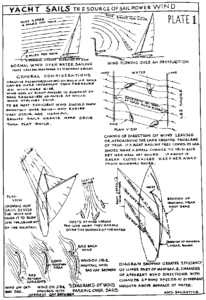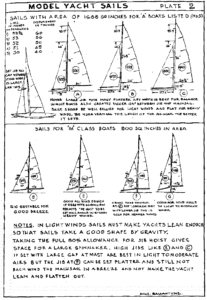The Design of Model Yacht Sails
by A.M. Ballantyne
Surprisingly little has been written about the designing and effect of sail-plans as applied to yachts, but periodic fashions in sails seem to come and go, and each in turn is hailed as the best yet. Most writers content themselves with a statement that “the sails have to be suited to the hull they drive,” but the why or wherefore is omitted.
“Balance” has been boosted as a prerequisite of a hull, and most systems of “balance” stop right there; but an otherwise good hull can be made to act up badly when an improper sail-plan is used to drive it. So my first postulate is that “Balance is an overall affair, hull, sails, rig, and trim all enter into it.”
My second postulate is that “For any given hull, no one sail-plan is ideal for all sailing conditions.
The effect of my second postulate on the first is that for every change of wind direction and/or strength, adjustments to the sails, rig and trim are necessary to preserve balance and get the most speed out of the yacht.
In the “A” and “Wee Six” [6 Meter. – Ed.] classes the amounts of adjustments are strictly limited, so that it is necessary to make the best compromise possible for the average conditions met with on the pond most used, and this accounts in some degree for the non-success of visitors as against the “home skippers,” as boats adjusted to light weather and variable winds are difficult to sail in moderate to heavy straight winds; and vice-versa. These classes, because of their restrictions, produce the keenest and fairest competition.
The “M” and to a lesser degree, the “X-class,” by removing most of the restrictions of the “A-class,” permits variations of sails, rig, and trim to suit quite varied sailing conditions.
The hardest action of the wind to visualize is how a yacht can use the power of the wind to force itself against the wind. The trick is performed by using the peculiarity of of liquids and gasses, by which they exert pressure against surfaces that they pass over at right angles to the surface, so that the pressure of the wind on striking a sail is at right angles to the surface of the sail. As the sails are set at varying angles with the axis of the boat, she would normally be driven in a direction at right angles to the sails, were it not that the water is acting on the lateral plane of the yacht, in a similar manner to the wind acting on the sails, so that she moves forward, crab-fashion, mostly forward, but with leeway. The amount of pressure that the wind exerts on a yacht sailing “on the wind” can be analyzed into forward and side directions; an average for an “A-class” might be 1 1/2 lbs forward, and 6 lbs sideways, and for light winds and for smaller yachts, considerably less.
This small amount of forward drive requires that all parasitical resistances, such as thick masts, heavy rigging, badly-setting sails, and rough hulls be reduced to a minimum if the best speed through the water is to be obtained.
The sketches on Plate I indicate some of the vagaries of the wind, and draw attention to the areas of greatest efficiency in a sail-plan; first the jib, and second, the peak of the mainsail. These get the most favorable wind directions and also form the leading edge of the sail-plan.
The area adjacent to the leading edge creates the greatest forward pressure when sailing “on the wind” and this explains the greater efficiency of high sails, because they have a longer leading edge than low sails.
The almost universal use of vane steering has brought a rash of yachts with their rigs away forward so as to prevent the mainsail from backwinding into the vane-feather. This calls for a different placement of the lateral plane and beam in designing hulls. Alternatives to this in the case of “M” or “X” boats is to use heavy, stiff hulls with high, narrow, sail-plans, with large jibs, and for “A-type” boats with limited rule for height of rig, an easily driven hull with a small, full-height sail-plan.
By using a large jib, the mast is located well aft in the sail-plan. One of the worst objections to the rig placed well forward is that the mast-weight, being well forward of the center of buoyancy, depresses the bow when sailing off the wind, and introduces changes in trim when the boat is leaning on the wind, so that raking the mast aft must be resorted to as a means of overcoming this.
Yacht designers try to suit the hull to the sail-plan presented with the design, and is well to try out this official sail-plan, but if good results are not obtained after a thorough trial, then a series of experiments are in order. These experiments could include: a) Changes to the height of the sail-plan; b) Changes in proportion of jib area to mainsail area; c) Changes in displacement, which in the case of “A-Class” and “6-M Class” usually require some change in the sail area.
A common fault is inability to strike a trim that will suit different weights of wind, and is is most likely to occur with boats that are overcanvassed and cannot be kept out of the wind in a breeze, and fall off in light winds when the mast is well forward and the jib sheeted in to suit the heavy going. The best compromise trim is to use a spring or a rubber kick-strap on the main boom, so that the top of the mainsail is flapping in the breeze, and the boat sails mainly on the jib, which should have the jib-rack hook in line with the jib-stay, so that the jib keeps a good gap at the mast even in the light spots. This sailing on the jib will be most effective if the jib is not too small.
Long water-line boats with high, narrow sail-plan are much the easiest to balance. On some X-boats, for instance, the mast can be moved 2 or 3 inches, and they will still sail; but a best position for the mast should be found where the boat makes the greatest speed in the different strengths of wind.
Now consider one fo the common problems of the model boatman the case where the wind is quite light at the start or finish of a race, but breezes up at times to five or more miles. The best that can be done with the “A class” is to use well bellied sails for the light going, and flatter sails for the heavy breeze. This can be accomplished by the use of loose-footed sails, by adjusting the outhaul, and varying the backstay, or by changing sails. Unfortunately some boats will not trim when the sails are bellied, so they are sluggish in light going. However, the problem is easier to handle with the “M” or “X” classes, where in the lighter going a high rig will give the best results, but a lower rig should be used for breezier conditions. However, this necessitates two complete changes during the race and unless the skipper has his rigs well tested out and tuned up beforehand, he is liable to lose races while tuning up. A better way is to have jibs of various shapes, and use the high narrow ones for light airs, and the lower ones for the breeze.
A high jib will give the best drive up to the time it has a depressing effect in the heavier going, and the low jib will keep the boat’s head out of the wind and give better control.

